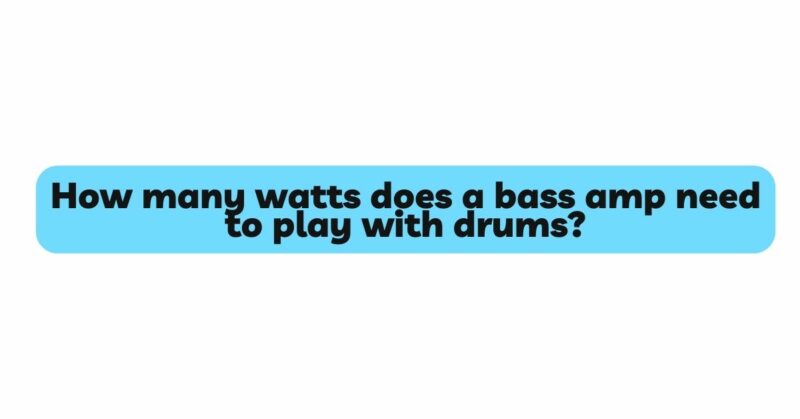In the dynamic world of music, where beats and melodies converge, the collaboration between a bassist and a drummer forms the rhythmic backbone that drives a composition forward. Yet, this musical partnership is only as powerful as the tools it employs. When it comes to playing with drums, the question emerges: How many watts does a bass amp need to seamlessly integrate with the percussive force of a drum kit? This question unravels a realm where sonic balance, projection, and collaboration shape the contours of a compelling musical experience. In this article, we journey through the intricacies of wattage for a bass amp in drum-infused sessions, deciphering the harmonious blend that allows the rhythmic duo to shine.
The Nexus of Drums and Bass: Playing with drums requires a finely tuned synergy between the bass and percussion elements. As the drummer lays down the rhythmic foundation, the bassist’s role is to provide the low-end groove, anchoring the composition and adding depth and resonance to the sound. In this dynamic interplay, the bass amp’s wattage becomes a pivotal factor in achieving a balanced and immersive sonic landscape.
Deciphering Amplifier Wattage: Wattage, in the context of bass amplifiers, signifies the power output that propels the sound through the speakers. It’s a measure of the amp’s capability to project sound at varying volumes. For drum-infused sessions, the right wattage ensures that the bass cuts through the percussive elements while maintaining tonal integrity and precision.
Crucial Aspects of Wattage in Drum-Infused Sessions: When determining the wattage required for a bass amp in sessions with drums, several crucial aspects come into play:
- Volume Equilibrium: The wattage must strike a balance between the drum kit’s volume and the bass guitar’s projection. This equilibrium ensures that the bass remains audible and contributes to the composition’s depth without overpowering the drums.
- Tonal Clarity: Adequate wattage enables the bass amp to reproduce the full tonal spectrum of the bass guitar, including its low-end frequencies. This clarity ensures that the bass sound doesn’t get lost amidst the percussive elements.
- Dynamic Range: The wattage affects the amp’s ability to handle dynamic shifts. In drum-infused sessions, where the intensity varies, an appropriate wattage allows the bassist to mirror the drummer’s dynamics effectively.
- Sound Projection: The right wattage ensures that the bass’s sonic projection reaches all corners of the performance space, creating a cohesive sonic experience for both musicians and the audience.
Factors Influencing Wattage for Drum-Infused Sessions: Several factors influence the wattage required for a bass amp in sessions with drums:
- Drumming Style: The drummer’s style impacts the drum kit’s volume and intensity. A more aggressive playing style might necessitate higher wattage to maintain the balance.
- Room Acoustics: The dimensions and acoustics of the performance space influence how sound is distributed. A larger space might demand higher wattage to ensure even coverage.
- Playing Style: The bassist’s playing style also matters. If you engage in dynamic techniques or switch between fingerstyle and slap, an appropriate wattage can accommodate the variations in playing intensity.
- Ensemble Size: If the ensemble includes multiple instruments, including guitars and vocals, a higher wattage might be required to compete with the overall volume level.
Balancing Wattage and Drum Volume: For drum-infused sessions, a bass amp with wattage ranging from 100 to 300 watts is often recommended. This range strikes a balance between volume, tonal clarity, and projection:
- 100 to 150 Watts: Amps in this range are suitable for smaller ensembles and more controlled playing environments. They provide ample volume to cut through the drums without overpowering them.
- 200 to 300 Watts: In larger ensembles or louder playing contexts, higher wattages ensure that the bass remains distinct amidst the drumming intensity. They also provide additional headroom for dynamic shifts.
Benefits of Lower Wattage:
- Balanced Dynamics: Lower wattage amps can maintain a balanced dynamic range, allowing the bassist to mirror the drummer’s nuances effectively.
- Focused Sound: In smaller ensembles, lower wattages provide a focused sound projection that complements the overall sonic landscape.
- Energy Efficiency: Lower wattage amps consume less power, making them suitable for practice and performances where energy conservation is essential.
Benefits of Higher Wattage:
- Ensemble Performance: Higher wattage amps are well-equipped to handle larger ensembles, ensuring that the bass remains audible and impactful in complex musical arrangements.
- Dynamic Playing: If your playing style involves dynamic techniques and variations in intensity, higher wattages can accommodate these shifts without compromising tonal clarity.
- Stage Presence: When performing in larger venues or with louder instruments, higher wattages provide the necessary projection and presence.
Tone Shaping and Equalization: Amps equipped with tone controls and equalization options allow you to shape your sound to suit the context. These controls compensate for any tonal imbalances that might arise due to the drum volume and the amp’s wattage.
Sound Checks and Adaptation: Conducting thorough sound checks with the full ensemble is essential. This process lets you fine-tune your bass amp’s settings and wattage according to the drum volume and the overall sonic dynamics.
Conclusion: Crafting a Rhythmic Tapestry: The ideal wattage for a bass amp in drum-infused sessions is a symphony of collaboration, precision, and responsiveness. It harmonizes the bass’s grooves with the drum kit’s rhythms, creating a tapestry of sound that resonates with depth and resonance. By thoughtfully aligning your wattage choice with the drummer’s style, room acoustics, ensemble size, and the unique demands of the music, you craft a sonic partnership that accentuates the synergy between bass and percussion. The result is a performance that pulsates with energy, resonates with audiences, and encapsulates the essence of rhythmic resonance in its purest form.


